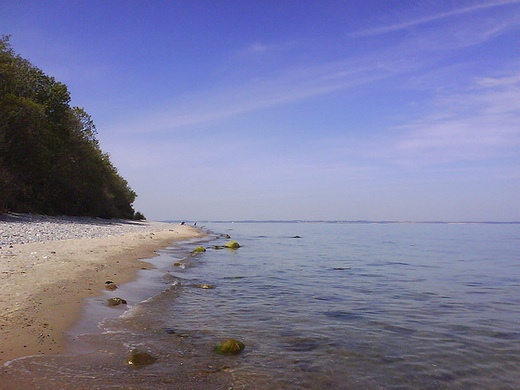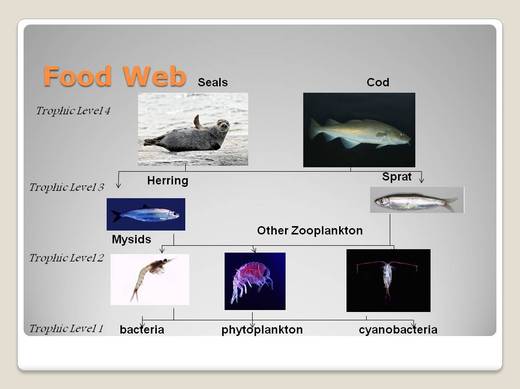The Baltic Sea
Title Text.
Table of Contents
Introduction
Basic Information
Biodiversity and Habitats
Food webs and Major Organisms
Historical Use
Habitat changes
Major Fisheries
Fisheries Mangagement
Introduces Species
Pollution
Eutrophication and the Dead Zone
What can be done
Introduction
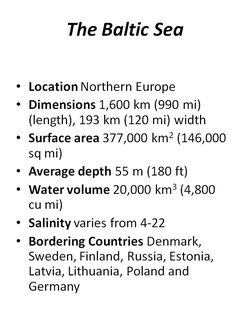
The Baltic sea has a long history of human usage and unfortunatley pollution. This northern sea is sometimes refered to as one of the most polluted seas because oh its history. The baltic sea has more to offer than just its problems. The sea also has many uses such as for its fisheries, shipping, recreation, and beauty. There are many natural wonders of this sea including breathtaking fjords, sandy beaches, and temperate climate. In order to preserve all the species from the sea, action need to be taken to protect this important sea.
Basic Information
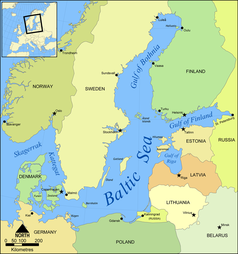
[2]
The Baltic sea is located in northern Europe and is considered a smaller sea with a surface area of 377,000 km2 which is approximately the size of the state of Montana. With an average depth of 55 meters, the Baltic sea is a very shallow sea[1].
Two other characteristics of the sea are that is it brackish and a mediterranean style sea. It is considered mediterranean because there is a very restricted flow of water going in and out of the sea. Many of the seas major freshwater inputs are located in the two northern bays making these areas have a very low salinity [1]. In the south part of the sea it is more marine dominated because of the higher salinity. The sea is also dependent on salinity and differences in water density to mix the water and not wind[2].
The Baltic sea is a fairly young sea, estimated at being in its current condition for the last 4,000 years [1]. The sea was created by glacial melting which transformed the basin into a fresh water lake. With sea level raise due to glacial melt the straights around Denmark were opened up to the Baltic sea making the sea saline.
Two other characteristics of the sea are that is it brackish and a mediterranean style sea. It is considered mediterranean because there is a very restricted flow of water going in and out of the sea. Many of the seas major freshwater inputs are located in the two northern bays making these areas have a very low salinity [1]. In the south part of the sea it is more marine dominated because of the higher salinity. The sea is also dependent on salinity and differences in water density to mix the water and not wind[2].
The Baltic sea is a fairly young sea, estimated at being in its current condition for the last 4,000 years [1]. The sea was created by glacial melting which transformed the basin into a fresh water lake. With sea level raise due to glacial melt the straights around Denmark were opened up to the Baltic sea making the sea saline.
Biodiversity and Habitats
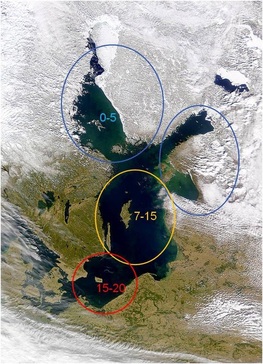
Salinity measurements [9]
Habitats
The Baltic sea has over 150 different habitats many being unique to the area.
The major habitats of the Baltic sea are:
The sea also has always had very low biodiversity. There are only 100 fish species within the sea. There are however estimated to be thousands of species in the sea with the biggest diversity in its phytoplankton[5]. Salinity has a major effect on the distribution of marine life within the sea. In the northern Gulf of Bothnia and east part of the Gulf of Finland, salinity levels are very low. Some freshwater species can actually be found here, but this is also the area of the sea with the lowest species richness [5]. The area with the highest species richness and biodiversity is located in the southern western part of the sea where salinity is the highest indicated by the red circle in the map. This biodiversity has already been heavily impacted by anthropogenic activities. Many are reducing their population with the effects of pollutants while other top predators are being removed or over-exploited. Even though this sea has low diversity it is important to preserve as it helps with overall ecosystem resilience.
The Baltic sea has over 150 different habitats many being unique to the area.
The major habitats of the Baltic sea are:
- Offshore (deep) waters
- Estuaries
- Sand and mudflats
- Seagrass beds
- Lagoons and fjords
The sea also has always had very low biodiversity. There are only 100 fish species within the sea. There are however estimated to be thousands of species in the sea with the biggest diversity in its phytoplankton[5]. Salinity has a major effect on the distribution of marine life within the sea. In the northern Gulf of Bothnia and east part of the Gulf of Finland, salinity levels are very low. Some freshwater species can actually be found here, but this is also the area of the sea with the lowest species richness [5]. The area with the highest species richness and biodiversity is located in the southern western part of the sea where salinity is the highest indicated by the red circle in the map. This biodiversity has already been heavily impacted by anthropogenic activities. Many are reducing their population with the effects of pollutants while other top predators are being removed or over-exploited. Even though this sea has low diversity it is important to preserve as it helps with overall ecosystem resilience.
Food Webs and Major Organisms
Title.
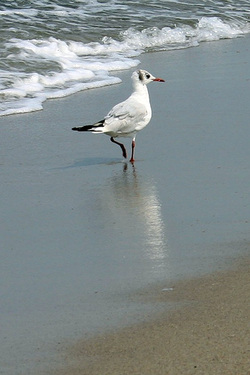
[19]
Because the Baltic sea has low biodiversity it has a simpleler food web than other ecosystems[5]. It does how ever have four main trophic levels and like other areas of the world the top trophic levels are the most highly threatened. In the top trophic level (4) it consists mostly of Atlantic cod which is highly over fished, seals , and some large sea birds. The last two having been highly effected by pollution and habitat loss that contributed to population declines. What this organisms eat consist of most of trophic level 3 which are pelagic fish. These fish are much smaller and are plankton eaters. The lower trophic level (2) are much of what the pelagic fish would eat. These are mostly zooplankton which are mostly herbivorous. The lowest level includes phytoplankton, bacteria, and cyanobacteria. Due to nutrient loading and some other factors this level is unusually high.
Historic Use
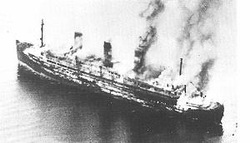
[16]
The Baltic sea has always been an area that has been heavily used by humans. Before commercial fishing the areas shores and near waters where fished by early settlements. After commercial fishing started in the area has been heavily exploited for fish protein. The Baltic sea has also been an area important for trade since it is the only waterway to many of the inland countries. Because of heavy amounts of shipping over such a long history the sea is also home to many pollutants. The sea has also been used historically to bury weapons of war such as explosives and other contaminated substances. Industries have also used to area as a waste point of organic pollutants such as POPs and even some nuclear waste [6].
Habitat Changes
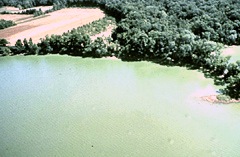
Eutrophication [17]
Because of heavy uses of the Baltic sea it has been left very polluted. The pollution has then lead to habitat changes within the sea. The biggest change is eutrophication. Nitrogen and phosphorus are major problems for the sea. The majority comes from non-point sources such as agriculture and is hard to control.
High levels of phytoplankton and their associated blooms also happen in conjuction with other reasons. Atlantic cod is the top preditor fish in the sea which keep the pelagic fish such as herring and sprat in check. The proplem is that cod is heavily overfished the a population that lets trophic level three increase in populations. The increase amount of pelagic fish consume higher than normal amounts of zooplankton whos job it is to keep the phytoplankton in check. Since the zooplanktons populations are so low they can not do this. Thus more phytoplankton and blooms. For this reason furture planning for management has included restoration of cod populations.
High levels of phytoplankton and their associated blooms also happen in conjuction with other reasons. Atlantic cod is the top preditor fish in the sea which keep the pelagic fish such as herring and sprat in check. The proplem is that cod is heavily overfished the a population that lets trophic level three increase in populations. The increase amount of pelagic fish consume higher than normal amounts of zooplankton whos job it is to keep the phytoplankton in check. Since the zooplanktons populations are so low they can not do this. Thus more phytoplankton and blooms. For this reason furture planning for management has included restoration of cod populations.
Major Fisheries
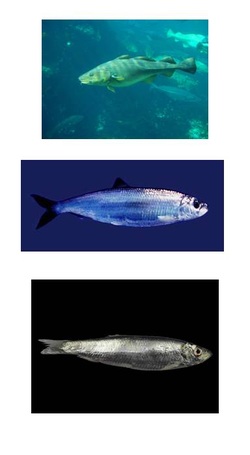
Atlantic Cod [14], Atlantic Herring [5], and European Sprat [15]
Ever since the beginning of humans fishing, the Baltic sea has been one that is heavily exploited. The sea is highly productive considering how small it is. In 2006 alone 686,493 tonnes of fish were caught in the sea. There are three main fish species that make up over 95% of the species caught.
Atlantic Herring: a pelagic fish species that resides in large schools. This fish is very abundant around the world. This fish feeds mostly on zooplankton. In 2006 227,625 tonnes were caught of herring in the Baltic sea equaling $62,664,309[3].
European Sprat: Also a pelagic fish that is found in schools, but it is not as high in value as the herring. This fish also feed primarily on zooplankton. In 2006 353,948 tonnes were caught valued at $92,605,940 [3].
Atlantic cod: This fish is the most valuable commercially fished fish in the Baltic sea. Prized for it white meat this fish has always been heavily fished. Cod is also higher up on the food chain and its main prey are sprat and herring. In 2006 only 63,885 tonnes were caught, but was worth $97,098,282 [3].
The majority of fish in the Baltic sea are caught by gillnets and mid-water trawls. Gillnets are used to caught approximately half of the cod in the sea. Whereas the majority of the sprat and cod are caught by mid-water trawls. Seine nets are also used today, but less frequently to catch cod and herring since this net targets schooling fish.
Atlantic Herring: a pelagic fish species that resides in large schools. This fish is very abundant around the world. This fish feeds mostly on zooplankton. In 2006 227,625 tonnes were caught of herring in the Baltic sea equaling $62,664,309[3].
European Sprat: Also a pelagic fish that is found in schools, but it is not as high in value as the herring. This fish also feed primarily on zooplankton. In 2006 353,948 tonnes were caught valued at $92,605,940 [3].
Atlantic cod: This fish is the most valuable commercially fished fish in the Baltic sea. Prized for it white meat this fish has always been heavily fished. Cod is also higher up on the food chain and its main prey are sprat and herring. In 2006 only 63,885 tonnes were caught, but was worth $97,098,282 [3].
The majority of fish in the Baltic sea are caught by gillnets and mid-water trawls. Gillnets are used to caught approximately half of the cod in the sea. Whereas the majority of the sprat and cod are caught by mid-water trawls. Seine nets are also used today, but less frequently to catch cod and herring since this net targets schooling fish.
Fisheries Management
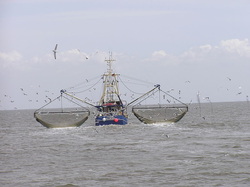
[18]
Since the collapse of most fisheries in the 1990s the European Union in conjunction with International Baltic Sea Fishery Commission (IBSFC). The EU also helps determine the enforcement of the quotas even though this is mostly done on an individual country level. The European Union and the IBSFC receive much of their information about fish stocks from The International Council for the Exploration of the Seas (ICES). This is an organisation that recieves its information directly from scientists about fish populations and health. It is then the ICES job to help interpret this data and pass it on. Their thoughts about TAC amounts are completely scientific and have no economic ties [6].
Introduced Species
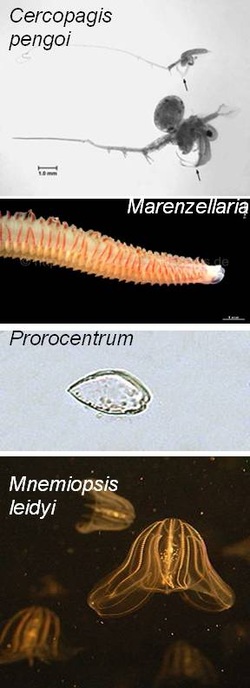
C.p [10], M. [11], P. [12], M.l [13]
Introduced species have been occurring at a faster rate because of the increase in shipping. There are now 120 non-native species located in the Baltic sea with the majority being brought through ballast water of ships. Approximately 80 of these species have firm groundings in the sea. The majority of the species originate from the Caspian sea and North America. Many have also established themselves in areas that are highly polluted because the ecosystems are more disrupted in these areas.
Four main species:
Cercopagis pengoi- a predatory water flea that appear in 1992. It competes with herring for food and originated from the Ponto-Caspian region.
Marenzellaria viridis- a polychaete worm that was first seen in 1995. It causes problems with benthic communities as it is able to out compete most other organisms.
Prorocentrum minimum- a type of phytoplankton that is now well established in the southern Baltic sea.
Mnemiopsis leidyi- also known as American comb jelly is a type of ctenophore that is a major cause for concern that was spotted in 2006. The same ctenophore has already caused population collapses in economically important species. It can also withstand water with low salinity and has predators in the Baltic sea [7].
Four main species:
Cercopagis pengoi- a predatory water flea that appear in 1992. It competes with herring for food and originated from the Ponto-Caspian region.
Marenzellaria viridis- a polychaete worm that was first seen in 1995. It causes problems with benthic communities as it is able to out compete most other organisms.
Prorocentrum minimum- a type of phytoplankton that is now well established in the southern Baltic sea.
Mnemiopsis leidyi- also known as American comb jelly is a type of ctenophore that is a major cause for concern that was spotted in 2006. The same ctenophore has already caused population collapses in economically important species. It can also withstand water with low salinity and has predators in the Baltic sea [7].
Pollution
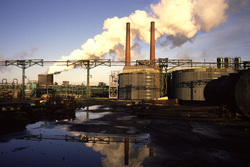
[20]
Predisposed to pollution
For many reasons the Baltic sea is highly affected by pollution. Approximately 85 million people live within 50 kilometers of the coastline which is densely populated for a sea smaller than the size of California [1]. The catchment of the sea is also quite large with freshwater input coming as east as Norway and as west as the Ukraine [2]. Many countries are responsible for the condition of the Baltic Sea and not just the bordering countries. The sea as has a long residence time for its water which is 30 years [2] which means that pollution in the water has little chance at getting exchanged out. If it does get exchanged out it is with water from the North Sea with is another polluted sea. Many species are already living at their physiological limits, and with the addition to pollutions to the brackish water it can limit ranges for certain species. This is one the Baltic sea is often referred to the most polluted sea in the world [7].
History
The Baltic sea has had one of the longest histories for pollution. Ever since the industrial revolution the sea has been heavily used by pollutant shipping methods as the Baltic sea provides some of the only water routes to certain countries[1].
Pollutants
Heavy metals are still a problem for the Baltic sea. The three major ones are cadmium, lead, mercury. Point source pollution from industries used to be the number one way that heavy metals entered the sea, but in the 1970s much disposal of heavy metals was banned [2]. Now a major way that these elements enter the sea is through atmospheric contamination. It is believed that as much as one half of lead and one forth of mercury enter the system in this way. Persistent organic pollutants are very similar to heavy metals and restrictions. They enter the sea through non- and point sources and from atmospheric sources. Many such as DDT and PCBs were banned in the 1970s as the trophic level magnification was understood after causing population collapses in sea birds and seals[2]. Nuclear testing by the United State and Soviet Union caused fallout over the Baltic sea. Also the Chernobyl nuclear accident in 1986 cause even higher fallout over the sea. In addition to this some authorized and unauthorized dumping of nuclear waste has gone into the sea, however the ramifications of this are not fully understood.
Eutrophication
Eutrophication a major problem that the Baltic Sea is currently deal with. Eutrophication is the over fertilization of water caused by massive increases of nitrogen and phosphorus.
For many reasons the Baltic sea is highly affected by pollution. Approximately 85 million people live within 50 kilometers of the coastline which is densely populated for a sea smaller than the size of California [1]. The catchment of the sea is also quite large with freshwater input coming as east as Norway and as west as the Ukraine [2]. Many countries are responsible for the condition of the Baltic Sea and not just the bordering countries. The sea as has a long residence time for its water which is 30 years [2] which means that pollution in the water has little chance at getting exchanged out. If it does get exchanged out it is with water from the North Sea with is another polluted sea. Many species are already living at their physiological limits, and with the addition to pollutions to the brackish water it can limit ranges for certain species. This is one the Baltic sea is often referred to the most polluted sea in the world [7].
History
The Baltic sea has had one of the longest histories for pollution. Ever since the industrial revolution the sea has been heavily used by pollutant shipping methods as the Baltic sea provides some of the only water routes to certain countries[1].
Pollutants
Heavy metals are still a problem for the Baltic sea. The three major ones are cadmium, lead, mercury. Point source pollution from industries used to be the number one way that heavy metals entered the sea, but in the 1970s much disposal of heavy metals was banned [2]. Now a major way that these elements enter the sea is through atmospheric contamination. It is believed that as much as one half of lead and one forth of mercury enter the system in this way. Persistent organic pollutants are very similar to heavy metals and restrictions. They enter the sea through non- and point sources and from atmospheric sources. Many such as DDT and PCBs were banned in the 1970s as the trophic level magnification was understood after causing population collapses in sea birds and seals[2]. Nuclear testing by the United State and Soviet Union caused fallout over the Baltic sea. Also the Chernobyl nuclear accident in 1986 cause even higher fallout over the sea. In addition to this some authorized and unauthorized dumping of nuclear waste has gone into the sea, however the ramifications of this are not fully understood.
Eutrophication
Eutrophication a major problem that the Baltic Sea is currently deal with. Eutrophication is the over fertilization of water caused by massive increases of nitrogen and phosphorus.
Eutrophication and the Dead Zone
Eutrophication also with the hydrology of the sea has created one of the largest dead zones in a sea [8]. The dead zone in the Baltic sea is believed to be induced from human activities and amplified from the natural features on the sea. Because of the hydrology of the sea, water is rarely mixed and water has a high length of residency which are natural conditions for hypoxia. The problem is that the hypoxic and anoxic areas of the sea are growing [8]. It is believed that possibly one third of the bottom of the sea is either hypoxic or anoxic. The bottom of the sea is very important for the lives of many species including the prised cod which stays in the cooler, more saline waters.
What can be done
The Baltic sea has many environmental problems, mostlyy caused by pollution and overfishing which has made its ecosystems vunerable.The solutions for creating a healther Baltic sea are complex. Many still wonder what can be done with the pollants in the water. So many countries and management makers strive for pollution prevention. In was only in the 1970s when countries around the Baltic sea decided to meet and stop the degredation of their sea. This was the Helsinki Convention in 1974. From there HELCOM was created to help in managing the recommendation for pollution prevention. However with this there is no enforcement and are only recommendations. Currently with all surrounding countries except Russia, they are governed by the EU. The EU has put out new regulations and goals for seas all over EU and the Baltic sea gets much of its information presented from HELCOM. To stop eutrophication and spreading of the hypoxic layer in the Baltic sea servere steps need to be taken. First, cod populations need to be restored to help prevent algal blooms. Second nitrogen from agriculture need to be more strictly regulated such as limiting the amount used since most gets runoff anyways. Third would be to reduce pollution in order to make the ecosystem healthy and more resiliant. This goals are not impossible and are very important in preservng the Baltic sea [4]
Picture references
[1] Baltic Sea Beach http://www.ipernity.com/doc/skep/2077615/
[2] Map http://commons.wikimedia.org/wiki/File:Baltic_Sea_map.png
[3]seal http://tolweb.org/onlinecontributors/app?page=ViewImageData&service=external&sp=40074
[4] cod http://commons.wikimedia.org/wiki/File:Atlantic-cod-1.jpg
[5] sprat http://content4.eol.org/content/2009/02/02/19/85819_large.jpg
[6] herring http://en.wikipedia.org/wiki/File:Herringadultkils.jpg
[7] Mysids http://en.wikipedia.org/wiki/File:Hemimysis_anomala_GLERL_4. jpg
[8] Other zooplankton http://en.wikipedia.org/wiki/File:Copepodkils.jpg and http://en.wikipedia.org/wiki/File:Hyperia.jpg
[9] map http://visibleearth.nasa.gov/view_rec.php?id=856
[10] http://en.wikipedia.org/wiki/File:Cercopagidae_GLERL_1.jpg
[11] http://content3.eol.org/content/2009/02/02/20/91772_large.jpg
[12] http://en.wikipedia.org/wiki/File:Prorocentrum_micans.jpg
[13] http://en.wikipedia.org/wiki/Mnemiopsis_leidyi
[14] http://en.wikipedia.org/wiki/File:Gadus_morhua-Cod-2-Atlanterhavsparken-Norway.JPG
[15] http://en.wikipedia.org/wiki/File:Sprattus_sprattus.jpg
[16] http://en.wikipedia.org/wiki/File:Cap_Arcona_burning.jpg
[17] http://en.wikipedia.org/wiki/File:Potomac_river_eutro.jpg
[18] http://en.wikipedia.org/wiki/File:Krabbenkutter_Ivonne_Pellworm_P5242390jm.JPG
[19]http://www.flickr.com/photos/98652633@N00/219461817/
[20] http://www.geograph.org.uk/photo/757490
[2] Map http://commons.wikimedia.org/wiki/File:Baltic_Sea_map.png
[3]seal http://tolweb.org/onlinecontributors/app?page=ViewImageData&service=external&sp=40074
[4] cod http://commons.wikimedia.org/wiki/File:Atlantic-cod-1.jpg
[5] sprat http://content4.eol.org/content/2009/02/02/19/85819_large.jpg
[6] herring http://en.wikipedia.org/wiki/File:Herringadultkils.jpg
[7] Mysids http://en.wikipedia.org/wiki/File:Hemimysis_anomala_GLERL_4. jpg
[8] Other zooplankton http://en.wikipedia.org/wiki/File:Copepodkils.jpg and http://en.wikipedia.org/wiki/File:Hyperia.jpg
[9] map http://visibleearth.nasa.gov/view_rec.php?id=856
[10] http://en.wikipedia.org/wiki/File:Cercopagidae_GLERL_1.jpg
[11] http://content3.eol.org/content/2009/02/02/20/91772_large.jpg
[12] http://en.wikipedia.org/wiki/File:Prorocentrum_micans.jpg
[13] http://en.wikipedia.org/wiki/Mnemiopsis_leidyi
[14] http://en.wikipedia.org/wiki/File:Gadus_morhua-Cod-2-Atlanterhavsparken-Norway.JPG
[15] http://en.wikipedia.org/wiki/File:Sprattus_sprattus.jpg
[16] http://en.wikipedia.org/wiki/File:Cap_Arcona_burning.jpg
[17] http://en.wikipedia.org/wiki/File:Potomac_river_eutro.jpg
[18] http://en.wikipedia.org/wiki/File:Krabbenkutter_Ivonne_Pellworm_P5242390jm.JPG
[19]http://www.flickr.com/photos/98652633@N00/219461817/
[20] http://www.geograph.org.uk/photo/757490
Literature references
[1] Binnenmeer Ostsee. By Ulrich Neumann. Planet Wissen, 1 June 2009. Germany. Rundfunk Und Telemedien.
[2] Korpinen, Samuli et. al. Hazardous substances in the Baltic Sea - An integrated thematic assessment of hazardous substances in the Baltic Sea. Balt. Sea Environ. Proc. No. 120 B (2010).
[3] "LME: Baltic Sea." Sea Around Us Project. 2010. Web. Dec. 2. <http://www.seaaroundus.org/lme/23.aspx>
[4] Hinrichsen, Don. "The Baltic and North Seas." Coastal Waters of the World: Trends, Threats, and Strategies. Washington, D.C.: Island, 1998. 45-56.
[5] HECOM 2009 Biodiversity in the Baltic sea - An integrated thematic assessment on the biodiversity and nature conservation in the Baltic Sea: Executive Summary Balt. Sea Environ. Proc. NO.116A.
[6] "Catch Management in the Baltic Sea." IBSFC. <http://www.ibsfc.org/>
[7] Helcom, 2010 Ecosystems Health of he Baltic Sea 2003-2007: Helcom Initial Holistic Assessment. Balt. Sea Environ. Proc. No. 122
[8] Conley et al. (2009) Hypoxia-Related processes in the Baltic Sea. Environ. Sci. Technol, 43 (10), 3412–3420
[2] Korpinen, Samuli et. al. Hazardous substances in the Baltic Sea - An integrated thematic assessment of hazardous substances in the Baltic Sea. Balt. Sea Environ. Proc. No. 120 B (2010).
[3] "LME: Baltic Sea." Sea Around Us Project. 2010. Web. Dec. 2. <http://www.seaaroundus.org/lme/23.aspx>
[4] Hinrichsen, Don. "The Baltic and North Seas." Coastal Waters of the World: Trends, Threats, and Strategies. Washington, D.C.: Island, 1998. 45-56.
[5] HECOM 2009 Biodiversity in the Baltic sea - An integrated thematic assessment on the biodiversity and nature conservation in the Baltic Sea: Executive Summary Balt. Sea Environ. Proc. NO.116A.
[6] "Catch Management in the Baltic Sea." IBSFC. <http://www.ibsfc.org/>
[7] Helcom, 2010 Ecosystems Health of he Baltic Sea 2003-2007: Helcom Initial Holistic Assessment. Balt. Sea Environ. Proc. No. 122
[8] Conley et al. (2009) Hypoxia-Related processes in the Baltic Sea. Environ. Sci. Technol, 43 (10), 3412–3420
Created by Danielle Kerr
Paragraph.
